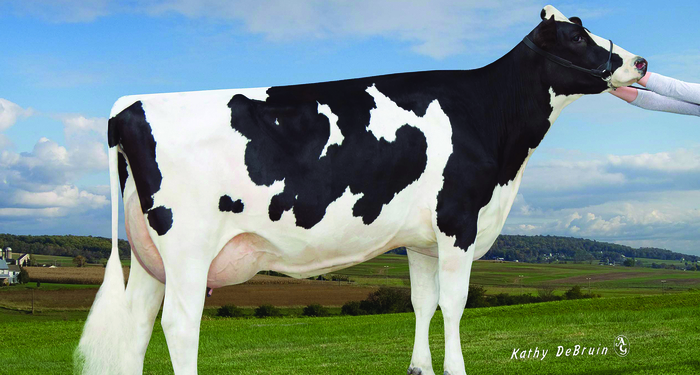December 2018 genetic evaluations published this week (4 December) by AHDB Dairy see a raft of modern bulls rise to the top which will improve their offspring’s health and welfare, while some will even breed daughters which are predicted to be cheaper to feed.
Pine-Tree CW Legacy is one such bull, who retains a Profitable Lifetime Index (£PLI) of over £900 and remains the leading bull amongst all young, genomic Holstein sires. He transmits improvements to his daughters’ mastitis (-4), lifespan (+0.7) and lameness (+2.3), while as calves, his offspring are expected to have high rates of survival (+2.4 for Calf Survival Index). Alongside good health, this son of Frazzled is expected to transmit solid production, with Predicted Transmitting Abilities (PTAs) of 913kg milk, +0.09% fat and +0.03% protein, while a negative score for Maintenance Index reflects saved feed costs of his daughters.
In second place, Denovo 7921 Atrium also retains his position from the previous ranking and, with a PLI of £878, becomes one of many leading bulls which bear the Denovo prefix and hail from a relatively new US joint venture between ABS Global and De-Su Holsteins. This ABS Achiever son excels when it comes to reducing feed costs associated with maintenance, with a Maintenance Index of -12. Other features of Atrium’s balanced breeding profile include high fat (45.1kg and +0.19%) and outstanding daughter fertility (+12.5).
The highest new entry comes in third place in the form of Peak AltaLeap, also bearing a prefix which features strongly at the top of the rankings. A son of De-Su Quantum, AltaLeap’s Lifespan Index of +0.8 gives his daughters a predicted 244 extra days of productive life compared to a bull whose LS is zero. His Calf Survival score is equally impressive at +3.2, and with a PLI of £871, he transmits all the usual production and health traits – especially reducing mastitis and cell counts – associated with the £PLI ranking.
With a PLI of £853, ABS Crimson (De-Su Spectre) moves up one place to fourth position, and is the highest weight of fat transmitter in the top 20 at a massive 47.9kg.
Paternal brother to Crimson is ABS Outback, featuring a high Lameness Advantage at +3.0 and excellent daughter Fertility Index at +12.5. His PLI is £847.
In sixth position is the second new entry, and one of eight new bulls in the top 20. Like the number two bull, Wilra ABS Amplify is an Achiever son, and he is predicted to transmit good milk components (+0.19% fat and +0.09% protein). With a PLI of £844, he transmits a cross-section of traits which will improve his daughters’ welfare and economic performance.
VH Balisto Brook now ranks in seventh place with a PLI of £842 and transmits exceptional udder health, with -37 for SCC and -6 for mastitis.
Another new entry in eighth position is Bomaz AltaCabot (£PLI 839). A son of Bomaz AltaTopshot, he is particularly notable for high fat transmission (44.2kg and +0.20%) and has a good Lameness Advantage at +2.9.
Mr Rubi-Agronaut now ranks in ninth position, and is another high percentage fat transmitter at +0.23%, which he combines with very high daughter fertility (+13.2) and a Type Merit of +3.15 – the highest in the top 20.
Rounding off the top 10 is Pine-Tree Durable (PLI £827), a Charley son and maternal brother to the number one bull, Legacy. Durable is predicted to have fewer daughters affected by lameness, with the best Lameness Advantage in the top 20 £PLI sires at +3.9.
UK breeding
Other highlights in the top 20 include the highest UK-bred sire, Glamour Boghill Victor, who ranks in 11th place and combines high milk (959kg) with low SCC (-28), good Calf Survival (+3.0) and a good Maintenance Index (-4).
Other front-runners
The lowest maintenance feed score in the top 20, however, goes to VH Bosman Bahrain at -13, while equal best Calf Survival goes to new entry, Denovo 14400 Advance. The best daughter Fertility Index is for Schoene AltaRobert, with an exceptional +14.8.
“Choosing the right genetics can make a significant difference to farm profitability, and by selecting appropriate bulls, it is now even possible to breed dairy replacements which cost less to feed,” says Marco Winters, head of animal genetics with AHDB Dairy. “This selection of bulls promises better economic performance than ever before and with feed costs this winter a particular concern, now may be a good time for dairy producers to focus attention on Maintenance Index amongst the subsidiary traits.
“Bulls with a low, or ideally negative maintenance score, are desirable, as they produce lighter daughters which require a lower input of feed for their maintenance.
“Of course, we would always recommend ranking on £PLI for the first screening of sires, but homing in on the component traits of this economic index – including Lameness Advantage, Maintenance Index, Calf Survival and Lifespan Index – can help improve replacement rates and lower costs on the farm.”


